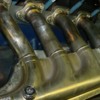quote:
You'll find most bolts are probably easiest from the top, but there will be 2 or 3 that are easier from the bottom.
When I replaced my header gasket on the driver's side, I found that removing the oil filter provided easier access to the bolts I had to access from below. Just remember to spin the filter back on when you finish tightening all the header bolts. I was in a hurry to finish up my project because we had dinner plans, so I buttoned everything up, forgot to put the oil filter back on, then fired her up. I hopped out of the car to check for any leaks and immediately noticed the loud ticking sound and looked in the engine compartment to see oil being furiously pumped onto my headers. I immediately shut it down. Now I had a river of oil running down the driveway. What a mess to clean up, both the driveway and the engine compartment and headers. Oh well, I guess it was time for an oil change anyway.
Cheers!
Garth


